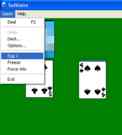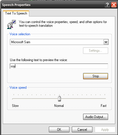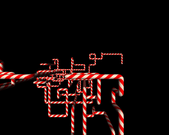Windows XP Easter Egg - Force Win and New Options in Solitaire (All Windows Versions)
To use this egg you will need a program called ResHack, to edit the
resorces in Sol.exe. Reshack is a freeware program available to download
at http://www.users.on.net/johnson/resourcehacker/
Ok, now when reshacker is installed, open it up, and open up
sol.exe. This will open the resorces for sol.exe. In the menu on the
left side, Expand "String Table", Then expand the folder "64", Then
click on 1033. You will see in the window on the right that there are
three strings, "Heck i dont know", "Prepare solatair for Screenshot" and
"Force Win". Notice the numbers at the bigining of them. These will be
used to make the egg visable in Solitaire. Here are the numbers:
1008, "Heck, I don't know"
1009, "Configure Solitaire for screen shots"
1010, "Force a win"
Now, to add these to the menu, Expand the menu folder, expand 1, and
select the file iside. This will display the strings that make up the
menu at the top in solitare. Select the entire text in this box, and
replace it with this:
1 MENU
LANGUAGE LANG_ENGLISH, SUBLANG_ENGLISH_US
{
POPUP "&Game"
{
MENUITEM "&Deal\t F2", 1000
MENUITEM SEPARATOR
MENUITEM "&Undo", 1001
MENUITEM "De&ck...", 1002
MENUITEM "&Options...", 1003
MENUITEM SEPARATOR
MENUITEM "E&xit", 1004
}
POPUP "&Help"
{
MENUITEM "&Contents\t F1", 65506
MENUITEM "&Search for Help on...", 65507
MENUITEM "&How to Use Help", 65508
MENUITEM SEPARATOR
MENUITEM "&About Solitaire", 2000
MENUITEM "&Egg 1", 1008
MENUITEM "&Egg 2", 1009
MENUITEM "&Egg 3", 1010
}
}
Now, click the compile Script button at the top of the screen. Now
save sol.exe. When you next launch solitare, open the 'help' menu. There
will be 3 new options, "Egg1" "Egg2" and "Egg3". Egg 1 and 2 do
nothing, but Egg 3 will let you win instantly. Egg 2 makes the picture
freeze so that publicity shots can be taken (when the cards fall). The
auther of solitar, Wes Cherry, Left the strings in when he made
solitaire for Microsoft, and so the "Eggs" can be re-enstated into
Solitare, they just need to be uncovered!





 candy!
candy!

